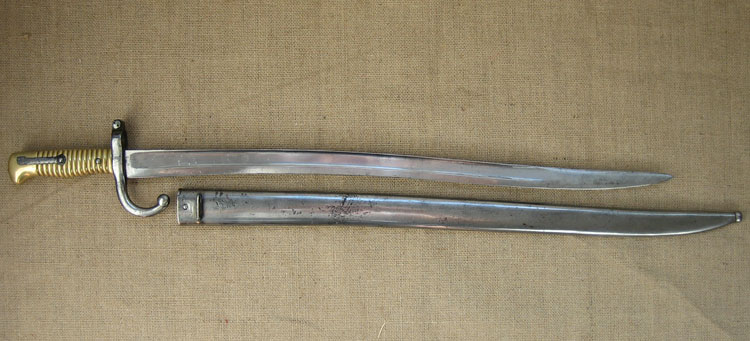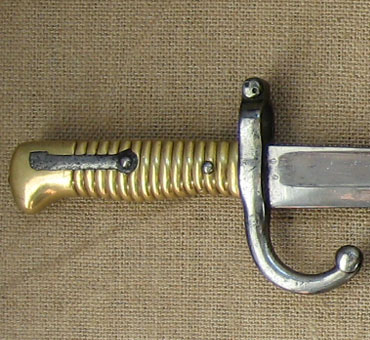
| Mle. 1866 "Chassepot"
Technical data : Total length : 694 mm Was used on : Mle. 1866 "Chassepot"
General information : During the Franco-Prussian (1870-1871) war this bayonet was part of the standard French soldiers’ equipment. In 1874 it was replaced by the Mle. 1874 for the Gras rifle but this was not the end of the Mle. 1866’s military career. During the First World War, the French equipped some of their troops behind the front with Mle. 1866 and Mle. 1874 to free up more modern rifles for frontline troops.The Germans, who had captured enormous quantities of French weapons during the Franco-Prussian war, issued their stocks of Mle. 1866 rifles and bayonets to border troops (Grenzschutz), home guard (Landwehr), guards in prisoner camps (Kriegsgefangenenlager) and other troops behind the front. These German used pieces were sometimes stamped with acceptance and troop marks on both the bayonet as the scabbards. The scabbards were modified by removing the frog lug and replacing it by a S1871 style frog stud. This bayonet could be the model that has been copied the most of all designs. It’s brass handle with 15 grooves and the yataghan blade are typical. The early, rarer, examples had a rivet in the second groove whereas most pieces have that rivet located in the third groove. There’s a screw on top of the muzzle ring, which is used to adjust the muzzle ring diameter. This allowed the bayonet to be fitted on rifles with slightly different muzzle diameters. These variations were due to the small imperfections in the industrial process in the middle of the 19th century. The handle itself was fitted with a leaf spring, an effective but vulnerable locking system. Throughout the years, many of these springs have weakened or got blocked due to corrosion. Every bayonets locking system should be tested before buying it and this rule definately applies to the Mle. 1866 as well. The back of the blade bears inscriptions that refer to time of production and the place where the bayonet was manufactured. There is absolutely no link to any Major or other officer, nor was it ever presented to Lieutenant Châttelerault, St.-Etienne or Tulle. These are the names of the places where the French factories were located. They were called “Manufacture Impériale” under the reign of Napoleon III, who was declared Empereur of the “Second Empire” in 1952. With the election of Louis Adolphe Thiers as the first French President France in became the “Troisième République” (Third Republic) in November 1870. The national factories then became known as “Manufacture Nationale” which changed once again in 1871 to “Manufacture”. The system used for the dates is a little peculiar as well. For the names of most months their French name was used but some were a combination of ciphers and letters. This relates to the Julian calendar, the predecessor of our current Gregorian calendar, where the new year started on the 1st of March. The list is Janvier (January), Février (February), Mars (March), Avril (April), Mai (May), Juin (June), Juillet (July), Aôut (August), 7bre (read as “septembre”, September), 8bre (read as “octobre”, October), 9bre (read as “novembre”, November) and Xbre (read as “décembre”, December). Known makers : Manufacture Impériale de Chatelleraut Images.
© www.bajonet.be |
||||||||||||||||||||||||||||||

